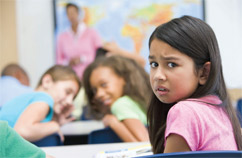Bullying is a worldwide occurrence that can have serious and sometimes long-term implications on victims such as depression and loneliness, and less extreme outcomes such as sleeping problems and feeling tired. More terrifying, bullying begins to emerge in the preschool years and is common among primary school children. When this happens, what part do you, as a parent, play?
Understanding Bullying
Bullying can be seen as verbal, psychological or physical behaviour intended to hurt someone less powerful. Many studies have also distincted bullying behaviour by gender, associating boys with physical attacks and girls with less subtle forms of verbal and psychological attacks. Examples of psychological bullying include, isolating the victim from activities, making faces, spreading rumours, and destroying or hiding victims’ belongings.
The Victims
Generally, there are two types of victim:
- Passive/Submissive victims: These victims are generally more anxious and insecure than other students. They are often cautious, sensitive and quiet. When attacked, they commonly react by crying or withdrawal and they usually have low self-esteem and negative view of themselves. They are also lonely and abandoned at school and usually do not have a good friend in class.
- Provocative victims: Characterised by a combination of anxious and aggressive reaction patterns, these students often have concentration problems and behave in ways that may cause irritation and tension around them. Their behaviour can sometimes provoke other students in their class, resulting in negative reactions from the others.
| What Adults Can Do |
|---|
|
As the implications have suggested, it is important for early intervention once the act of bullying is identified. You may also follow some of these suggestions if your child is a victim or a bully. |
|
Suggestions to your child’s school:
|
|
Suggestions to parents:
|






Comments